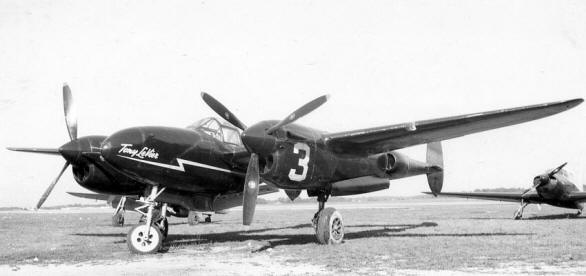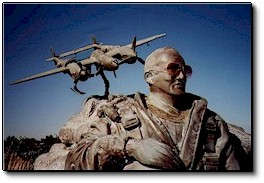Tony LeVier Biography
Tony LeVier was born on Valentine's Day (Feb 14) in 1913. He started early (got his pilot's license at 17!) and went on to become one of the top test pilots of his day.
Two years after getting his license, he won the aerobatic competition and took second in a challenging cross-country event at the Junior Pilots Air Meet in Long Beach, CA. His first race victory came at the Pacific International Air Races in 1938, and the next year he placed second in the Thompson Trophy Race -- America's greatest test of flying skill at the time.

He flew more "firsts"* than any other test pilot (20 in total) and went on to clock more than 10,000 flying hours in over 24,000 flights. Among the "firsts" were the F‑94 Starfire, the T‑33‑1, the XF‑104 Starfighter (the first USAF operational fighter to fly twice the speed of sound), the XP‑80 and the top-secret, high-altitude U‑2 reconnaissance prototype "spy plane."
LeVier flew many combat missions in P-38s and tested and flew many planes, on into the jet age, and He was at the wheel of another Lockheed aircraft (the F-90) when it became the first Lockheed plane to break the sound barrier.
He was one lucky sonofagun as he survived eight crashes and one mid-air collision in his career. LaVier kept flying and working at Lockheed until his retirement in 1974 (where he was then Director of Flying Operations). After retiring (ha ha), he founded "Safe Action in Flight Emergency, Inc., a non-profit group which helped train civilian pilots for emergency situations.
In the early days of the P‑38, LeVier received an emergency summons to get to England. Too many pilots where crashing in P‑38s in emergency situations due to lack of significant training on the new aircraft. Apparently the counter-rotating props, and the necessity of flying with one prop feathered was an adjustment for which the pilots had been ill-prepared. LeVier didn't blame the pilots, but the training. He proceeded to explain the pros and cons of the 38 and demonstrate various maneuvers, such as recovering from a dive and taking control with one engine feathered.
"Levier continued his demonstration tour and arrived at Kingscliff, home of the 20th Fighter Group. The pilots of the 20th were not overly impressed with his lecture. Levier proceeded to take up his P‑38 (equipped with the new dive flaps). At 25,000 ft., Levier dove straight down, and the pilots rushed out to see what they thought would be a crash. Levier easily pulled out without any problems, and for extra emphasis, he preformed several low level one-engine rolls. The current P‑38s in the ETO were not equipped with this flap, but he was attempting to showcase the new features, which would be arriving soon. The pilots were shown that they would be able to pursue a German fighter diving out of trouble. The demonstration was indeed successful." (This story dedicated by the P‑38 Online website, which is no longer online.)
LeVier was deservedly named to the National Aviation Hall of Fame, the International Aerospace Hall of Fame and the OX5 Club's Aviation Pioneers Hall of Fame, the Smithsonian Air and Space Museum's Lifetime Achievement in Aviation and Flight Safety Award. He also received the James H. Doolittle Award from the Society of Experimental Test Pilots.

